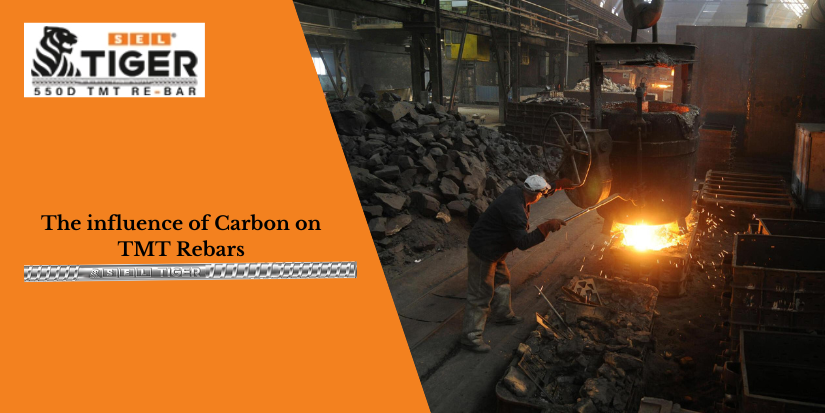
TMT bars are known for the fundamental role they play in reinforcing concrete structures. These bars add stability, strength, flexibility and durability to construction. One of the key elements in the manufacturing of TMT bars is Carbon. Carbon is a versatile element and is widely known for its bonding properties. How does it influence, and what properties does it add to the SEL Tiger TMT rebar? Let’s delve into the science behind TMT bar production to reveal the indispensable properties of TMT bars.
BIS recommends a specific amount of carbon in TMT bars that balances strength and ductility in TMT bars. When carbon is added in a controlled amount in the presence of oxygen in the manufacturing process of primary steel it significantly influences the mechanical properties of steel, including strength, hardness and ductility. In the production of TMT bars, carbon acts as an alloying element that imparts specific characteristics to the TMT bars.
The hardenability of steel is the role of carbon present in it this eventually gives toughness to the TMT bars. The toughness of steel alloys is the ability to stand up to repeated cycles of rigorous use without any wearing. In structural construction toughness of the TMT bar is required to ensure the longevity of the construction.
With the increase in carbon in steel the ductility of steel decreases, which is why steel bars with low carbon content are more ductile over TMT bars made of steel alloy that has high carbon content. In SEL Tiger TMT, the Carbon percentage for the Fe-550D and Fe-500D bar is only 0.25%. At SEL Tiger TMT rebar, we maintain the recommended carbon content for TMT bars which is equal to or less than 0.3%. With such a low percentage of carbon content, we assure the TMT bars are highly flexible, ductile, and easy to work with.
Carbon reinforcements enhance the durability of TMT bars, ensuring prolonged service life in harsh environments. Exposure to moisture and chemical agents can lead to corrosion and compromise the integrity of traditional steels over time. However, TMT steel bars with carbon content form a protective oxide layer, shielding the bars from corrosive elements and inhibiting rust formation. This inherent durability minimises the maintenance requirements and extends the lifespan of structures, reducing lifecycle costs and enhancing overall sustainability.
Steel has excellent circulatory properties which means scrape iron can be reused to manufacture fresh TMT bars. Carbon-infused TMT bar is a better choice as it preserves the mechanical properties of the bars even after recycling. Embracing carbon-rich TMT bars such as our SEL Tiger TMT rebars promotes circular economy principles, contributing to resource conservation and waste reduction in the construction industry.
TMT bars which have 0.2-0.3% carbon content have high ductility which adds the machineability feature in the TMT bars. To be used in different frameworks and for a range of applications, this feature allows TMT bars to be more flexible and versatile in application.
TMT bars are an integral part of construction, where welding is important for connecting two bars. Carbon content in the TMT bar facilitates the seamless integration of two bars to create complex structural frameworks. The carbon content ensures proper fusion during welding, creating robust connections that distribute loads efficiently across the structure. This weldability feature enhances construction efficiency while maintaining structural stability.
In addition to mechanical properties, carbon plays a crucial role in enhancing the resistance to corrosion of TMT bars. Carbon exhibits a natural ability to create a protective layer when exposed to atmospheric condition which helps prevents rusting and corrosion. The SEL Tiger TMT rebar stringently meets the carbon content ranges approved by BIS guidelines.
In conclusion, the role of carbon in TMT bars cannot be overstated. At SEL Tiger, we add carbon during the manufacturing process of pig iron and reduce it to the required percentage during the manufacturing of the primary steel. With a low carbon percentage, we ensure optimal strength, ductility, and corrosion resistance in our TMT bars, making them ideal for construction projects where durability and structural integrity are paramount. Our meticulous control over the carbon content of SEL Tiger TMT rebars guarantees the reliability and longevity of our products, setting a standard of excellence in the industry.
Read Also: Addressing common misconceptions about corrosion-resistant TMT bars in India
The carbon content when added in a controlled amount as per BIS recommendation ensures optimal performance. With SEL Tiger TMT Rebars which have a low percentage of carbon (equal to or less than 0.3%), we ensure TMT bars from Fe-415 to Fe-600 are ductile, highly flexible and have ease of workability.
Carbon makes the steel tougher, however, high-carbon steel is not easy to work with. Low-carbon steel is better for construction. But it is not enough to make TMT bars strong, to make low-carbon steel high-strength, phosphorus, silicon and manganese are added.
Looking for the best TMT bar dealership in India? Write to us today at contact@shyamgroup.com